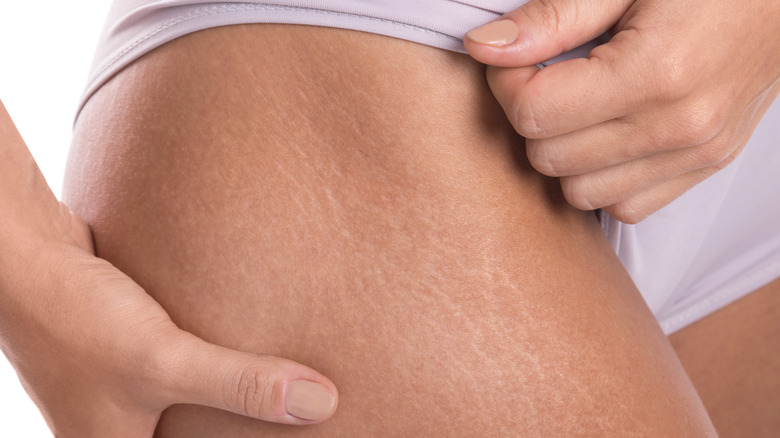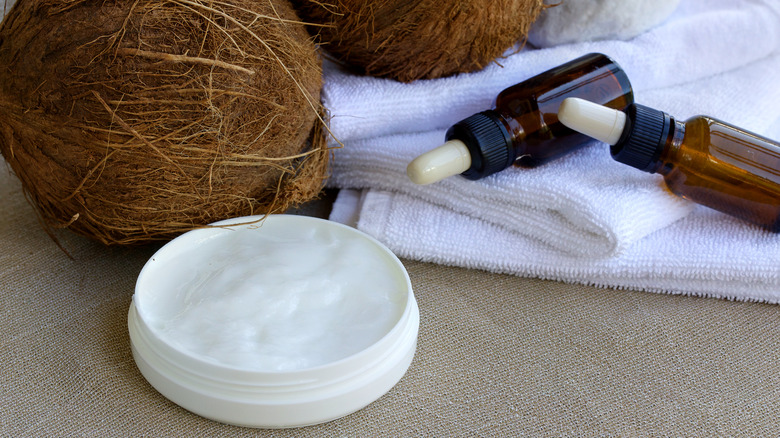Does Stretch Mark Cream Really Work?
Trying to get rid of stretch marks? In this case, you may be thinking about using creams, lotions, or home remedies. Perhaps you're also willing to try cosmetic treatments or even surgery. But, as the U.K'.s National Health Service points out, it's almost impossible to eliminate these scar-like lines. However, you may be able to reduce their appearance.
Anyone can develop stretch marks, regardless of age, gender, or body weight. Also known as striae distensae, this condition affects up to 90% of pregnant women and about one-third of teenagers, according to a recent study published in Cureus. Aging, genetics, obesity, and some medications, such as topical steroids, all seem to play a role. Researchers also say that stretch marks are more common in smokers and people with chronic conditions like diabetes or high blood pressure.
This scarring usually appears on the breasts, thighs, and stomach, but it can also occur on the arms or back. Though harmless, stretch marks can take a toll on your confidence and self-esteem. On the positive side, there are steps you can take to make your skin look smoother and more even. One option is to use stretch mark creams. These products won't eliminate the problem, but the results may be worth it.
The truth about stretch mark removal creams
Stretch marks occur when the skin stretches or shrinks over a short period, such as during pregnancy or following massive weight loss. This process breaks down collagen and elastin, the proteins that keep your skin flexible, leaving scars behind. The scars are unlikely to disappear, but they may fade over time, notes the Cleveland Clinic.
A popular treatment is retinol, a vitamin A derivative available in cream form. Retinol creams may improve skin texture and hydration levels, but in some cases, they can cause irritation, dryness, and sensitivity to light. Dermatologist Hadley King and other experts interviewed by Cosmopolitan say that retinoids, such as adapalene or high-strength tretinoin, may also boost elastin and collagen production, leading to smoother skin in just six months.
The research is mixed, though. For example, a 2015 review concluded that most creams and lotions are unlikely to prevent or treat stretch marks. Some studies found that tretinoin and other topical products may improve skin appearance, but they were either biased or too small to produce conclusive results, reports the Journal of the European Academy of Dermatology and Venereology (JEADV).
For example, Bio-Oil, a cream that claims to reduce stretch marks, has been proven effective in two studies. The problem is that both studies were only available on the manufacturer's website and haven't been published in peer-reviewed journals, notes JEADV. Therefore, their findings may be biased.
Should you still be using stretch mark creams?
Stretch mark creams yield different results for different people. Take tretinoin, for example. In an earlier study, this compound reduced the size and severity of stretch marks, making them less noticeable. Although it didn't increase collagen or elastin production, most patients experienced significant improvements, according to the Archives of Dermatology. Another study, which appeared in the journal Archives of Dermatology Research, found that silicone, an ingredient in stretch mark creams and gels, can stimulate collagen production.
How you use these products matters, too, says the American Academy of Dermatology Association (AAD). For best results, apply the cream to new stretch marks and massage it into your skin. Use it daily for several consecutive weeks. The AAD also recommends asking your doctor for prescription creams containing tretinoin or hyaluronic acid.
Alternatively, you can try coconut oil, tea tree oil, and other home remedies that can reduce the appearance of stretch marks, but they may or may not work. However, these products are generally safe and widely available, so that you could use them along with a prescription-strength cream.
As the AAD notes, cosmetic procedures are often more effective than topical treatments. Ultrasound therapy, chemical peels, microdermabrasion, and radiofrequency can significantly improve skin appearance, though they cannot eliminate the problem. Last but not least, you could try excisional surgery, but this option is only recommended in more severe cases and can cause further scarring.


